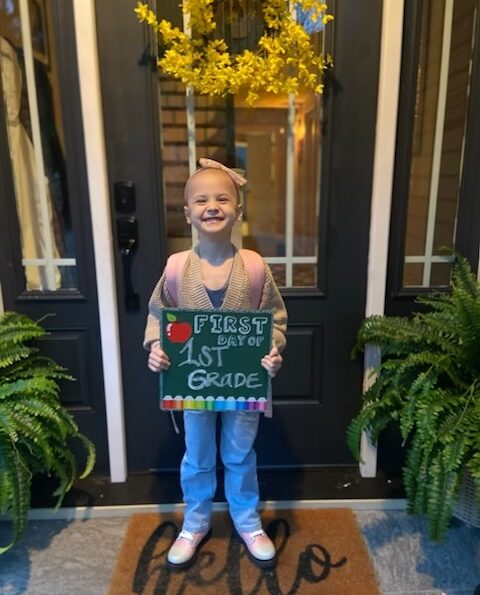Clinical trial spells ‘freedom’ for kids with leukemia

If you met 6-year-old Kinsley Cuzzetto, one of the first things you might learn is that she loves music.
Her dad, Chuck Cuzzetto, describes Kinsley as “a born performer” who belts out renditions of “Hound Dog,” among other Elvis tunes, with panache.
In 2023, this devoted Elvis fan was folding laundry with her dad when he got the phone call that no parent ever wants to receive. Earlier that day he had taken Kinsley to her pediatrician to investigate some intermittent swelling and bruising on the left side of her body.
“When the doctor called, she told us that she had gotten Kinsley’s lab results back and that she likely had leukemia,” Chuck says. “We needed to go to the emergency room immediately. We were all pretty terrified.”
At Mary Bridge Children’s Hospital, they met with Robert Irwin, MD, a pediatric hematologist-oncologist among Seattle magazine’s Top Doctors. Further tests revealed that Kinsley had B-cell acute lymphoblastic leukemia (B-ALL), a form of cancer that affects white blood cells and bone marrow.
“Dr. Irwin was so empathetic, candid and patient with us,” Chuck says. “He explained what the path ahead looked like and answered all our questions. We were still in shock, but he helped reassure us that we would get through this.”
From inpatient to ‘in control’

Robert Irwin, MD, pediatric hematologist-oncologist
Kinsley’s journey through treatment began with a month-long hospital stay at Mary Bridge Children’s, where she received chemotherapy. Part of her treatment also included participating in a phase 3 clinical trial for blinatumomab (blina), a type of therapy that helps the immune system identify and destroy cancer cells.
“Blina is the standard frontline treatment for a cancer that returns after remission,” says Dr. Irwin, who is also a principal investigator for the trial. “What we don’t know is how to best use blina for patients who have just been diagnosed with B-ALL.”
Mary Bridge Children’s is a member of the Children’s Oncology Group, the world’s largest network of children’s hospitals and research organizations studying childhood cancers. Research advances achieved through this group have enabled pediatric oncologists like Dr. Irwin to identify children who are at high risk for disease relapse, which includes Kinsley.
“Blina is generally well tolerated — with few or no side effects,” Dr. Irwin says. “The trial aims to find out whether we can eliminate the extra relapse risk for these kids by adding blina to standard chemotherapy.”
On the go with a blina backpack

Kinsley ready to rock out at Zach Bryan with her blina backpack.
Thanks to a portable IV infusion pump — one of five donated by the Mary Bridge Brigade — Kinsley could participate in the trial without the burden of another lengthy hospital stay.
“The donation of these pumps has been a real game-changer for patients and their families,” says Julianne Pugh, BSN, BMTCN, RN-CRA, a former clinical research associate (now retired) at the MultiCare Institute for Research & Innovation.
The Research Institute partners with MultiCare facilities like Mary Bridge Children’s, as well as community medical practices, to offer leading-edge research opportunities for pediatric and adult patients.
Pugh was instrumental in securing the donation from the Mary Bridge Brigade and developing a system to help families manage the portable infusion pumps on an outpatient basis.
“Before we had the pumps, patients were required to stay in the hospital for the entire length of the 28-day infusion of blina,” she says. “With two rounds of infusion, that could mean eight weeks in the hospital. That’s a real burden and resulted in a lot of families declining to participate in the study.”
Now, following only a two- to three-day hospital stay, as well as education about how to use the pump, patients can receive blina at home. Housed discreetly in a little red backpack, the pump delivers a continuous infusion of blina while allowing patients like Kinsley to live life to the fullest.
“She’d run around, play on the playground, dance, sing and just get to be a kid thanks to that pump,” Chuck says. “To not have to go in and out of the hospital during that part of her treatment has been a gift.”
Another gift? Progress in the fight against B-ALL, the most common type of childhood leukemia. An interim analysis of the trial showed such remarkable results that the study was closed early.
When added to chemotherapy, blina produced significantly superior outcomes for pediatric patients with B-ALL compared to chemotherapy alone, reducing the chance of relapse by over 50 percent and improving three-year survival rates by approximately 10 percent.
A concert to remember
Today, Kinsley is still in active treatment. In addition to receiving multiple rounds of chemotherapy, she has received two rounds of investigational blina.
Her journey, as is often the case, has been full of highs and lows. Shortly after her diagnosis, she had to stop attending school and has experienced many of the challenging side effects commonly associated with chemotherapy, such as fatigue and hair loss.
But through it all, according to Chuck, Kinsley’s spirit has been indomitable and their family has been grateful for the care they’ve received at Mary Bridge Children’s.
“The team at Mary Bridge has just been fantastic — caring and compassionate every step of the way,” Chuck says. “We developed such great relationships with the nurses and doctors in both the clinic and the hospital. They would go out of their way to make Kinsley smile.”
In November 2024, Kinsley was well enough to attend the concert of one of her favorite artists, Zach Bryan.
“Kinsley knows most of his songs by heart and Zach’s music has really helped us get through some hard times,” Chuck says. “Her care team helped coordinate her treatment to ensure we could go and experience the concert to the fullest.”